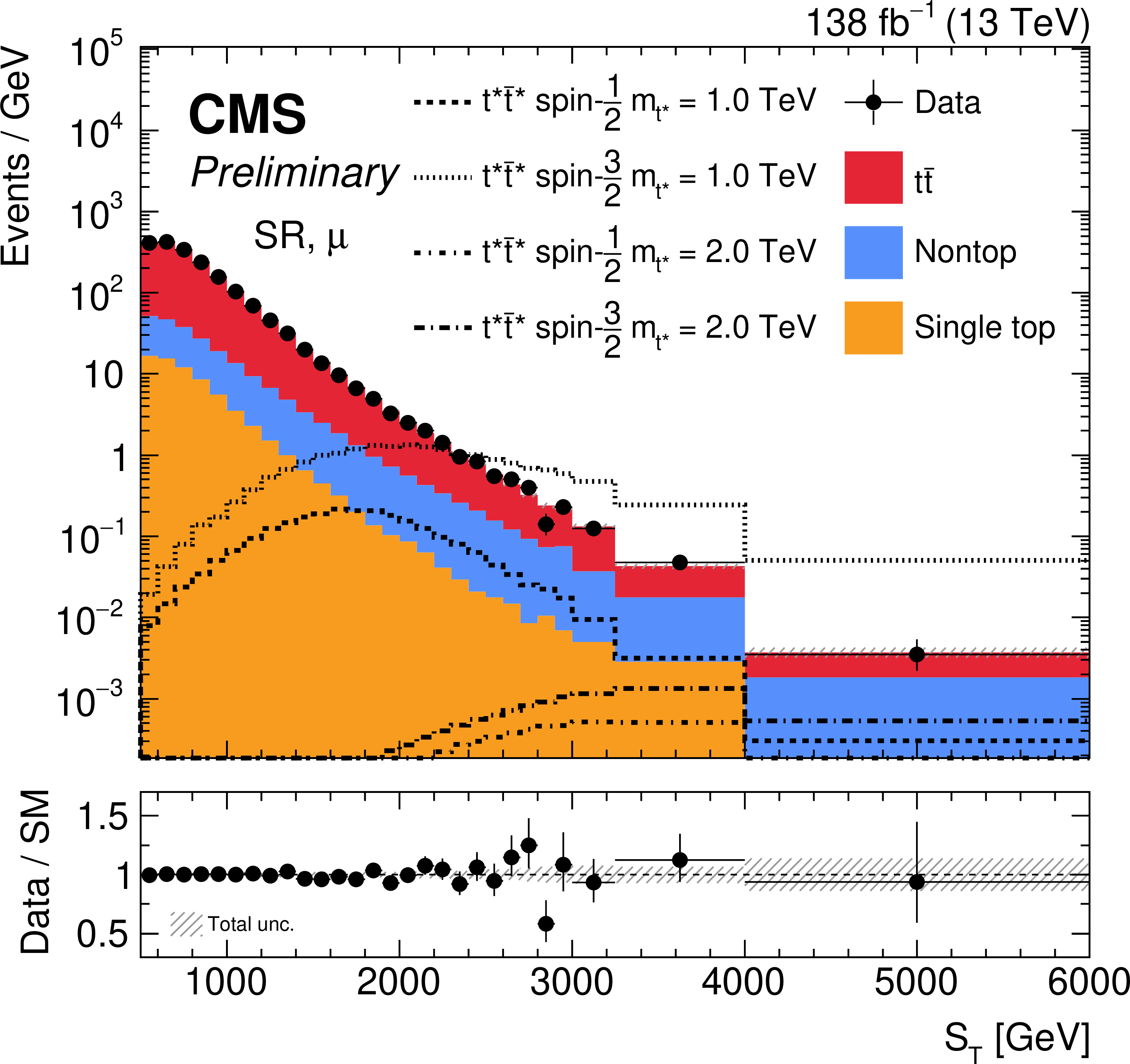
With the discovery of the Higgs boson in 2012, an important piece in our puzzle to understand the Universe was found. However, there are still many open questions: why is the Higgs boson so light? What is dark matter? How does gravity work at a fundamental level? Physicists have proposed many different theories on how these questions could be answered. Many of them involve new particles, and therefore, searching for these new particles is a good way to test these theories. The top quark, the heaviest known elementary particle with a mass of about 172 GeV (corresponding to roughly 180 times the proton mass), is especially interesting in this context. Some theories propose that this particle is not elementary, but made up of some even smaller substructure. In that case, there could be an “excited” version of the top quark, t*, made of the same constituents but heavier. Should the excited top quark exist, it could behave similarly to the top quark, but would be heavier and unstable: it would decay into a top quark while releasing the difference in mass in the form of energy by, e.g., emitting a gluon (the particle associated to the strong force). This process would be the strong-force equivalent of an atom emitting a particle of light (a photon) when going from an excited state to its “ground state”, the kind of process exploited in our everyday life such as in lasers.
Physicists at the CMS experiment analyzed billions of LHC proton-proton collisions, recorded between 2016 and 2018, and searched for t* particles. At the LHC, t*’s are expected to be produced in pairs, in processes very similar to those of top quark-antiquark pair productions, tt. Figure 1 shows an event recorded by the CMS detector with a signature very similar to that of the t*t* signal.
Figure 1: Visualization of a signal-like event recorded with CMS, as selected by the DNN used in the analysis. A muon is shown as a red line together with jets that are visible as yellow cones. The missing energy is shown as a pink arrow. You can zoom and rotate in this separate page.
The search is performed using a special observable, called ST. "Because the t* particle is most likely very heavy, as previous searches have ruled out its existence for masses below 1200 GeV, a considerable amount of energy would be released into our CMS detector. How much energy is released in a single collision is measured by the ST variable, constructed as a momentum sum of many different particles reconstructed in the detector.", explains Finn Labe, who is graduating at the University of Hamburg and leads the analysis effort. However, just by looking at this one variable, it is still almost impossible to find signs of t*t* events: they are simply too rare and would be buried under a large number of events from known processes. Compared to the tt process, which happens millions of times in our data, a t*t* event is expected to happen a few times only. With classical methods, it’s very challenging to find this needle in the large haystack of known physics. Therefore, we make use of advanced data analysis techniques using artificial neural networks.
The analysis team trained a so-called deep neural network (DNN) that receives features from the decay products of both t*t* and tt, and constructs a discriminator to distinguish between the two. Although the ST variable is not given directly as input to our DNN, the network can learn about the total energy of the event from other features, and even mostly decides based on this quantity. This means that our network cannot improve much upon our single variable, ST. In order for the DNN to provide additional discrimination power, we have altered the training process so that the ST difference between t*t* and tt is hidden from the network. Finn Labe explains: “What we have done, known as decorrelation, is often used in high energy physics. For example, such an approach is employed to consistently identify particles in the detector, independent of their momentum.”

Figure 2: The distribution of ST for data (black points) and predicted backgrounds (colored histograms) together with the potential contributions of signal events with different t* masses and spins (dashed and dotted lines).
Figure 2 shows the distribution of ST in data, compared with predicted backgrounds, after rejecting events too similar to the tt hypothesis, according to the neural network. Considering different scenarios for t* mass and spin, distributions for t*t* processes are also overlaid. The agreement between data and predicted backgrounds suggests no sign of t*. The statistical analysis of the data in comparison with predictions excludes the existence of an excited top quark up to a mass of 1700 GeV. This is a substantial improvement over our previous knowledge, increasing our sensitivity by a factor of about 10, thanks to the advanced usage of artificial neural networks. More data, currently gathered by the CMS detector, as well as additional improvements of analysis techniques, will help us further increase our sensitivity and maybe find a sign of excited top quarks.
Edited by: Muhammad Ansar Iqbal
Read more about these results:
-
CMS Physics Analysis Summary (B2G-22-005): " Search for pair production of heavy particles decaying to a top quark and a gluon in the lepton+jets final state at 13 TeV "
-
Display of collision events: CERN CDS
-
@CMSExperiment on social media: Bluesky - Facebook - Instagram - LinkedIn - TikTok - Twitter/X - YouTube

